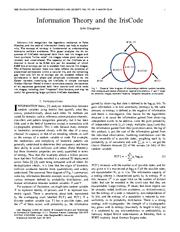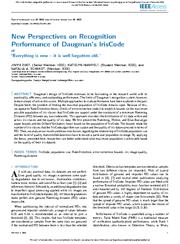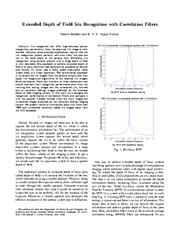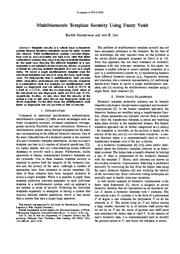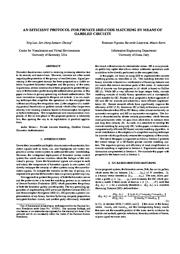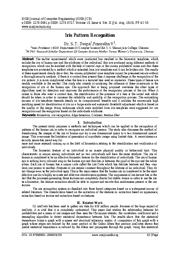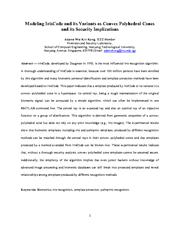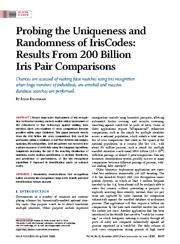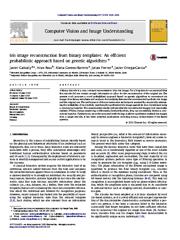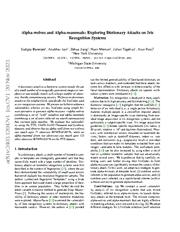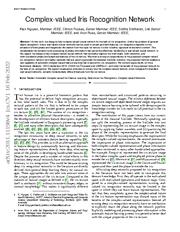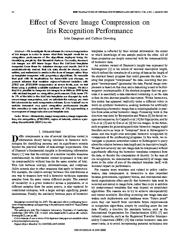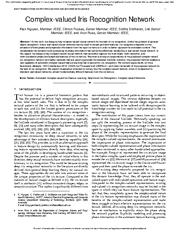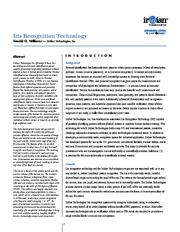A copy of this work was available on the public web and has been preserved in the Wayback Machine. The capture dates from 2019; you can also visit the original URL.
The file type is application/pdf.
Filters
Information Theory and the IrisCode
2016
IEEE Transactions on Information Forensics and Security
Iris recognition has legendary resistance to False Matches, and the tools of information theory can help to explain why. ...
in both phase and amplitude introduced by the Gabor wavelets underlying the IrisCode. ...
ACKNOWLEDGMENTS The author would like to thank Markus Kuhn for generating the white noise images, and Cathryn Downing for running the Markov process simulations. ...
doi:10.1109/tifs.2015.2500196
fatcat:jy7jwjzypzc2vputftcjydaqgm
New Perspectives on Recognition Performance of Daugman's IrisCode or "Everything is new – it is well forgotten old."
2021
IEEE Access
Most Rate-Distortion theory results are presented in the form of bounds. Below we provide a brief summary of three upper bounds and illustrate how to apply them to the IrisCode. ...
each carrying phase information and representing iris classes) into a set of binary codewords, each of length = 245 bits. ...
doi:10.1109/access.2021.3130100
fatcat:c2j5wouynvfa5jmfrnnsxw6kua
Extended Depth of Field Iris Recognition with Correlation Filters
2008
2008 IEEE Second International Conference on Biometrics: Theory, Applications and Systems
In this work we investigate the recognition performance of correlation filters and compare it with the popular iriscode method when the input images are unrestored images produced by the wavefront coding ...
The conventional approach is to restore the iris images from the camera outputs and then apply iris recognition algorithms to the restored iris images. ...
This means that, at least in theory we can recover the original information and acheive greater depth of focus at the same time. ...
doi:10.1109/btas.2008.4699371
fatcat:t6sykhpzobh35ppadp2gj4i3ke
Multibiometric Template Security Using Fuzzy Vault
2008
2008 IEEE Second International Conference on Biometrics: Theory, Applications and Systems
Further, we also show that the security of the system is only 41 bits when the iris and fingerprint vaults are stored separately. ...
On the other hand, the multibiometric vault based on fingerprint and iris provides 49 bits of security. ...
One of the main vulnerabilities of a biometric system is the exposure of a user's biometric template information. ...
doi:10.1109/btas.2008.4699352
fatcat:ige4njghnfbhpcgzswc47wdx3y
An efficient protocol for private iris-code matching by means of garbled circuits
2012
2012 19th IEEE International Conference on Image Processing
Signal processing in the encrypted domain has been proposed as a viable solution to protect biometric templates and the privacy of the users. ...
The computational and communication complexity of the on-line phase of the proposed protocol is extremely low, thus opening the way to its exploitation in practical applications. ...
Moreover, GC is likely to become a more efficient alternative than HE as GC theory relies almost exclusively on symmetric encryption and HE on asymmetric encryption. ...
doi:10.1109/icip.2012.6467444
dblp:conf/icip/LuoCPLB12
fatcat:aw6yprapfvglvl7mya3mevaxlq
Iris Pattern Recognition
2016
IOSR Journal of Computer Engineering
of recognition, which can be matched with the help of central rays in the convex polyhedral cones and that these templates are protected by a method which is extended from Iris-templates and it can be ...
The astonishing success of Iris-templates depends deeply on its computational benefits and it includes the enormously high matching speed for identification of iris on a large-scale and automatic threshold ...
between IrisCode and other coding methods. ...
doi:10.9790/0661-1804024350
fatcat:62o5ji2gqff7zinicqmfqfkxqi
Modeling IrisCode and Its Variants as Convex Polyhedral Cones and Its Security Implications
2013
IEEE Transactions on Image Processing
IrisCode, developed by Daugman in 1993, is the most influential iris recognition algorithm. ...
cones and that templates protected by a method extended from IrisCode can be broken into. ...
Acknowledgements We would like to thank the University of West Virginia, the University of Beira Interior and the Hong Kong Polytechnic University for sharing their databases, Prof. ...
doi:10.1109/tip.2012.2227770
pmid:23193454
fatcat:csf2jrgpmfhohllj47dffacd64
Probing the Uniqueness and Randomness of IrisCodes: Results From 200 Billion Iris Pair Comparisons
2006
Proceedings of the IEEE
Empirically analyzing the tail of the resulting distribution of similarity scores enables specification of decision thresholds, and prediction of performance, of the iris recognition algorithms if deployed ...
Chances are assessed of making false matches using iris recognition when huge numbers of individuals are enrolled and massive database searches are performed. ...
His areas of research and teaching are computer vision and biological vision, pattern recognition, information theory, and neural computing. ...
doi:10.1109/jproc.2006.884092
fatcat:vbbkuofzvjd2plj5dgtbgwtzym
Iris image reconstruction from binary templates: An efficient probabilistic approach based on genetic algorithms
2013
Computer Vision and Image Understanding
For a long time it was assumed that the iriscode did not contain enough information to allow for the reconstruction of the original iris. ...
image and the original one. ...
Javier Galbally would also like to thank Arun Ross of the Integrated Pattern Recognition and Biometrics Laboratory (iPRoBe) at West Virginia University for hosting him and collaborating with him during ...
doi:10.1016/j.cviu.2013.06.003
fatcat:mwwripbahneyxlwcygi2mck3oi
Alpha-wolves and Alpha-mammals: Exploring Dictionary Attacks on Iris Recognition Systems
[article]
2023
arXiv
pre-print
We focus on dictionary attacks at the template level, specifically the IrisCodes used in iris recognition systems. ...
We evaluate this vulnerability using the IITD, CASIA-IrisV4-Thousand and Synthetic datasets, and observe that an alpha-wolf (from two wolves) can match upto 71 identities @FMR=0.001%, while an alpha-mammal ...
Alternatively, in the context of information theory, Daugman suggests that there should be no uncertainty about the identity X denoted by a biometric signal Y , i.e., H(X|Y ) = 0 [9] . ...
arXiv:2403.12047v1
fatcat:wi5xm454kfbklapzwlexnfhxmm
Complex-valued Iris Recognition Network
[article]
2022
arXiv
pre-print
This necessitates the extraction and processing of phase information that cannot be effectively handled by a real-valued neural network. ...
Unlike the problem of general object recognition, where real-valued neural networks can be used to extract pertinent features, iris recognition depends on the extraction of both phase and magnitude information ...
model and retain phase information through the whole network. ...
arXiv:2011.11198v4
fatcat:yq3why462zawjn4g3fpqx2htdm
Effect of Severe Image Compression on Iris Recognition Performance
2008
IEEE Transactions on Information Forensics and Security
Only some 2% to 3% of the bits in the IrisCode templates are changed by such severe image compression, and we calculate the entropy per code bit introduced by each compression scheme. ...
Currently, standard iris images are 600 times larger than the IrisCode templates computed from them for database storage and search; but it is administratively desired that iris data should be stored, ...
One of Shannon's fundamental insights in formulating information theory [1] was that the entropy of a random variable measures simultaneously its information content (expressed in bits) and its compressibility ...
doi:10.1109/tifs.2007.916009
fatcat:i4zqjhtskfewbdqfaic7skhwea
Complex-valued Iris Recognition Network
2022
IEEE Transactions on Pattern Analysis and Machine Intelligence
This necessitates the extraction and processing of phase information that cannot be effectively handled by a real-valued neural network. ...
Unlike the problem of general object recognition, where real-valued neural networks can be used to extract pertinent features, iris recognition depends on the extraction of both phase and amplitude information ...
Explicitly modeling and processing phase information in the automatic feature learning process Fig. 1 : The classic IrisCode depends on the complex-valued Gabor response followed by phase quantization ...
doi:10.1109/tpami.2022.3152857
pmid:35201979
fatcat:zvy5ora5wbftrek3jv7oljkdta
Morton Filters for Superior Template Protection for Iris Recognition
[article]
2020
arXiv
pre-print
Through a set of experiments, we demonstrate the applicability of proposed approach and vet the strengths and weakness. ...
and also analyzing the discriminable bits across various subjects. ...
In the remainder of this paper, we present the principles and theory of Morton Filters in Section 2 . Section 3 presents the approach of template protection using Morton Filters mechanism. ...
arXiv:2001.05290v1
fatcat:tuzhp3yd7bcg3nwczvjyweol4a
Iris recognition technology
1997
IEEE Aerospace and Electronic Systems Magazine
The resulting IrisCode record is compared to each and every IrisCode record enrolled in the database for recognition. ...
Bit #1 from the presented IrisCode record is compared to bit #1 from the reference IrisCode record, bit #2 from the presented IrisCode record is compared to bit #2 from the reference IrisCode record, and ...
doi:10.1109/62.575997
fatcat:on53xaeah5h7be6gweqovcvzpa
« Previous
Showing results 1 — 15 out of 114 results

